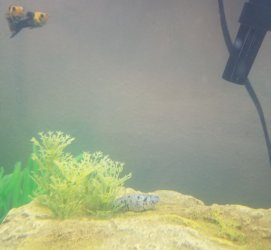Hi and welcome to the forum

I need a better picture of the fish to confirm this, but it appears the fish has dropsy. This is characterised by the scales sticking out sideways. Dropsy is usually caused by an internal bacterial infection and there is no cure for it. If the fish's scales are sticking out sideways from the body, you should euthanise it.
If the scales are not sticking out from the body, you can try adding salt. Before you add salt, do a 75% water change and gravel clean the substrate. Make sure any new water is free of chlorine/ chloramine before it's added to the tank.
--------------------------
You can add rock salt (often sold as aquarium salt), sea salt or swimming pool salt to the aquarium at the dose rate of 1 heaped tablespoon per 20 litres of water. If there is no improvement after 48 hours you can double that dose rate so there is 2 heaped tablespoons of salt per 20 litres.
If you only have livebearers (guppies, platies, swordtails, mollies), goldfish or rainbowfish in the tank you can double that dose rate, so you would add 2 heaped tablespoons per 20 litres and if there is no improvement after 48 hours, then increase it so there is a total of 4 heaped tablespoons of salt per 20 litres.
Keep the salt level like this for at least 2 weeks but no longer than 4 weeks otherwise kidney damage can occur. Kidney damage is more likely to occur in fish from soft water (tetras, Corydoras, angelfish, gouramis, loaches) that are exposed to high levels of salt for an extended period of time, and is not an issue with livebearers, rainbowfish or other salt tolerant species.
The salt will not affect the beneficial filter bacteria but the higher dose rate will affect some plants. The lower dose rate will not affect plants.
After you use salt and the fish have recovered, you do a 10% water change each day for a week using only fresh water that has been dechlorinated. Then do a 20% water change each day for a week. Then you can do bigger water changes after that. This dilutes the salt out of the tank slowly so it doesn't harm the fish.
--------------------------
What is the GH (general hardness) and pH of your water supply. This information can usually be obtained from your water supply company's website or by telephoning them. If they can't help you, take a glass full of tap water to the local pet shop and get them to test it for you. Write the results down (in numbers) when they do the tests. And ask them what the results are in (eg: ppm, dGH, or something else).
Mollies need water with a GH around 250ppm and a pH above 7.0. If the GH is too low, the fish will have problems.



